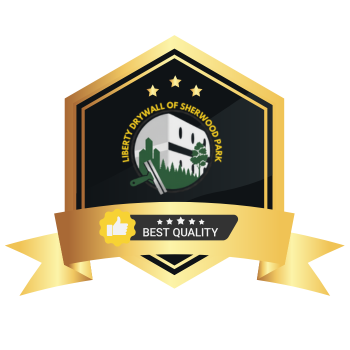Comprehensive Mold Remediation & Drywall Replacement in Sherwood Park, AB
When mold takes hold in your walls or ceilings, it can threaten both your home’s structure and your family’s health. At Liberty Drywall Sherwood Park, we provide full-service mold remediation and drywall replacement to restore safety, strength, and peace of mind to your property.
Our certified technicians use moisture detection, HEPA filtration, and antimicrobial treatments to completely remove contamination and prevent future mold growth. Whether you’re dealing with black mold in the basement, bathroom wall damage, or water-damaged ceilings, our team ensures your home is properly decontaminated and rebuilt using mold-resistant materials that stand up to Alberta’s humid conditions.
For prompt, professional service in Sherwood Park, call 587-418-8862 today to schedule your inspection and get expert help from Liberty Drywall, your trusted local drywall and restoration specialists.

Liberty Drywall of Sherwood Park (CP)

Comprehensive Mold Remediation Services in Sherwood Park
Liberty Drywall Sherwood Park provides complete mold remediation solutions that address contamination at its source through thorough inspection, specialized removal techniques, and targeted treatment of affected drywall systems. Professional assessment identifies moisture sources while decontamination processes eliminate harmful spores and restore structural integrity.
Professional Mold Assessment and Inspection
Your property requires thorough evaluation before any remediation begins. Certified technicians examine visible mold growth and use moisture detection equipment to locate hidden contamination within wall cavities and ceiling spaces.
Key Inspection Areas:
- Bathroom walls and ceiling joints
- Basement drywall near foundation walls
- Kitchen areas around plumbing fixtures
- HVAC system connections
Moisture testing reveals water intrusion sources that fuel mold growth. Digital moisture meters detect elevated humidity levels behind drywall surfaces before visible damage appears.
Documentation includes photographs and moisture readings for each affected area. This creates a detailed remediation plan that addresses both surface contamination and underlying moisture problems.
Drywall Mold Removal and Decontamination
Contaminated drywall requires complete removal when mold penetrates beyond surface layers. HEPA-filtered containment systems prevent spore dispersal during demolition and disposal processes.
Affected sections are cut back to clean, dry framing members. All contaminated materials are sealed in plastic sheeting and removed according to health regulations.
Decontamination Process:
- Surface cleaning with antimicrobial solutions
- Air scrubbing using HEPA filtration systems
- Structural treatment of exposed framing
- Moisture barrier application before new drywall
New drywall installation includes mold-resistant materials in high-moisture areas. Proper vapor barriers and ventilation prevent future contamination issues.
Black Mold Repair and Treatment
Black mold infestations demand specialized removal protocols due to potential health risks. Complete containment isolates affected areas from occupied spaces during treatment.
Personal protective equipment protects workers from toxic spore exposure. Negative air pressure systems direct contaminated air through HEPA filters before exterior discharge.
Structural repairs address water damage that created ideal growth conditions. This includes replacing damaged insulation, treating wood framing, and installing improved moisture control systems.
Treatment Verification:
- Post-removal air quality testing
- Surface sampling confirmation
- Moisture level documentation
- Visual clearance inspection
New drywall receives primer-sealer application before finish work begins. This creates additional protection against future moisture penetration and mold development.
Specialized Drywall Replacement for Mold and Water Damage
Water damage and mold contamination require specific drywall replacement techniques that go beyond standard repairs. Effective restoration involves proper assessment, structural repairs, and installation of moisture-resistant materials to prevent future problems.
Water-Damaged Drywall Restoration
Water-damaged drywall loses its structural integrity and becomes a breeding ground for mold growth. You need immediate assessment to determine replacement requirements.
Signs requiring replacement:
- Sagging or bulging walls
- Persistent musty odors
- Discoloration or staining
- Soft or crumbling texture
Your restoration process begins with moisture testing to identify affected areas. All saturated drywall must be removed at least 12 inches beyond visible damage.
Liberty Drywall Sherwood Park uses specialized equipment to detect hidden moisture behind walls. This prevents incomplete repairs that lead to recurring mold issues.
Restoration steps include:
- Complete moisture assessment
- Affected drywall removal
- Structural drying
- Antimicrobial treatment
- New drywall installation
You should never attempt to dry severely water-damaged drywall in place. The material's paper backing retains moisture and supports mold growth even after surface drying.
Structural Drywall Repair Solutions
Structural damage from water exposure requires comprehensive wall repair beyond surface-level fixes. Your home's framework may need reinforcement before new drywall installation.
Water damage often affects wooden studs and metal framing behind drywall. You need professional assessment to identify compromised structural elements.
Common structural issues:
- Rotted wooden studs
- Corroded metal framing
- Damaged electrical systems
- Compromised insulation
Your repair process must address these underlying problems first. Replacing drywall over damaged framing creates safety hazards and future failures.
Professional contractors like Liberty Drywall Sherwood Park coordinate with structural engineers when necessary. This ensures your wall repair meets building codes and safety standards.
Load-bearing walls require special attention during drywall replacement. You need temporary support systems during extensive structural repairs to maintain building integrity.
Mold-Resistant Drywall Installation
Mold-resistant drywall contains additives that inhibit fungal growth and resist moisture absorption. You should install these materials in areas prone to humidity and water exposure.
Recommended locations:
- Bathrooms and kitchens
- Basements and crawl spaces
- Areas with previous water damage
- Exterior walls
Your installation process requires proper sealing and moisture barriers. Standard installation techniques are insufficient for mold prevention.
Mold-resistant drywall costs 20-30% more than standard materials but provides long-term protection. You save money by avoiding future mold remediation and replacement costs.
Installation requirements:
- Vapor barrier installation
- Proper ventilation systems
- Antimicrobial primer application
- Sealed joint compound
You must combine mold-resistant materials with moisture control systems. Drywall alone cannot prevent mold growth without addressing underlying humidity issues.
Contact Liberty Drywall Sherwood Park at 587-418-8862 for professional mold-resistant drywall installation and comprehensive moisture control solutions.
Targeted Solutions for Common Mold Problem Areas
Different areas of your home require specialized mold remediation approaches due to unique moisture conditions and structural considerations. Bathrooms need ventilation improvements and waterproof materials, basements require comprehensive moisture control and full drywall replacement, while ceilings demand careful structural assessment and specialized repair techniques.
Bathroom Mold Repair
Bathroom mold develops primarily around tubs, showers, and sink areas where moisture accumulates daily. You need to address both surface contamination and underlying moisture issues to prevent recurrence.
High-Risk Zones:
- Behind toilet tanks
- Around bathtub caulking
- Shower wall corners
- Under sink areas
Remove all contaminated drywall and insulation within the affected zone. Install mold-resistant drywall specifically designed for high-moisture environments.
Improve ventilation by upgrading exhaust fans to move at least 50 CFM for standard bathrooms. Seal all penetrations with waterproof materials.
Apply antimicrobial treatments to framing before installing new materials. Use moisture barriers behind shower areas to prevent future water damage.
Replace standard drywall with cement board or moisture-resistant options in shower surrounds. This prevents future mold growth even if minor leaks occur.
Basement Drywall Replacement
Basement mold often affects large wall sections due to foundation moisture and poor air circulation. Complete drywall replacement becomes necessary when contamination extends beyond surface cleaning.
You must address the moisture source before replacing any materials. Check for foundation cracks, poor drainage, or plumbing leaks that contribute to humidity problems.
Replacement Process:
- Remove all contaminated drywall to studs
- Treat exposed framing with antimicrobial solution
- Install vapor barriers on exterior walls
- Use mold-resistant drywall products
Install proper dehumidification systems to maintain humidity below 50%. This prevents future mold growth on new materials.
Consider rigid foam insulation instead of fiberglass batts. Foam doesn't retain moisture and provides better thermal performance in below-grade applications.
Ceiling Mold Repair
Ceiling mold typically indicates roof leaks, plumbing issues, or condensation problems from above. You need immediate action since structural damage can occur quickly.
Identify the moisture source before beginning repairs. Check attic spaces, roof areas, and upper-floor plumbing for active leaks.
Remove contaminated ceiling drywall in sections to prevent debris from spreading spores throughout your living space. Use plastic sheeting to contain the work area.
Critical Steps:
- Inspect ceiling joists for structural damage
- Test insulation moisture levels
- Replace wet insulation completely
- Apply mold treatment to framing
Install new drywall with proper primer and paint designed for moisture resistance. Address ventilation issues that contributed to the original problem.
Monitor repaired areas for several months to ensure no recurring moisture issues develop.
Advanced Moisture and Mold Prevention Strategies
Effective moisture control and targeted remediation techniques form the foundation of long-term mold prevention in residential and commercial properties. Professional testing methods and specialized sanitation processes ensure comprehensive protection against future contamination.
Moisture Control Drywall Repair
Moisture control drywall repair addresses the root cause of mold growth by eliminating water intrusion points and installing vapor barriers. This process involves removing compromised drywall sections and treating the underlying structure.
Primary repair techniques include:
- Sealing wall cavities with moisture-resistant barriers
- Installing proper ventilation systems behind repaired sections
- Using mold-resistant drywall compounds and primers
Your contractor should identify moisture sources before beginning repairs. Common problem areas include plumbing leaks, HVAC condensation, and exterior water penetration through foundation cracks.
Material specifications:
- Type X or Type C moisture-resistant drywall
- Antimicrobial joint compounds
- Vapor-permeable paint systems
The repair process requires complete drying of wall cavities to moisture levels below 15%. Professional equipment monitors humidity levels during the 24-48 hour drying period before new drywall installation begins.
Drywall Moisture Testing and Odor Removal
Drywall moisture testing uses specialized equipment to detect hidden water damage and potential mold growth areas. Professional testing identifies moisture levels in wall cavities, insulation, and structural components.
Testing methods include:
- Pin-type moisture meters for surface readings
- Pinless meters for scanning large wall areas
- Thermal imaging cameras for detecting temperature variations
- Hygrometers for ambient moisture measurement
Your testing results determine the extent of remediation required. Moisture readings above 16% in drywall materials indicate active water damage requiring immediate attention.
Odor removal follows moisture elimination and involves treating affected surfaces with enzymatic cleaners. These products break down organic compounds that create musty smells associated with mold growth.
Odor treatment process:
- Remove contaminated materials
- Apply enzymatic cleaning solutions
- Use ozone generators for persistent odors
- Install activated carbon filtration systems
Professional odor removal typically requires 2-3 treatment cycles over 7-10 days for complete elimination.
Mildew Removal and Sanitation
Mildew removal requires different techniques than mold remediation due to its surface-level growth pattern. Sanitation protocols prevent cross-contamination during the cleaning process.
Effective mildew removal solutions:
- 3% hydrogen peroxide for porous surfaces
- White vinegar solution (10:1 ratio) for non-porous materials
- Commercial antimicrobial cleaners for heavy contamination
Your cleaning process should progress from least contaminated to most contaminated areas. This prevents spreading mildew spores to previously cleaned surfaces.
Sanitation procedures include:
- HEPA filtration during cleaning operations
- Disposal of contaminated cleaning materials
- UV-C light treatment for final surface sterilization
- Air quality testing post-remediation
Professional sanitation involves treating HVAC systems, replacing air filters, and cleaning ductwork. This comprehensive approach prevents mildew recurrence through airborne spore circulation.
Surface preparation before sanitation requires removing loose material and debris. Clean surfaces respond better to antimicrobial treatments and maintain their protective properties longer.
